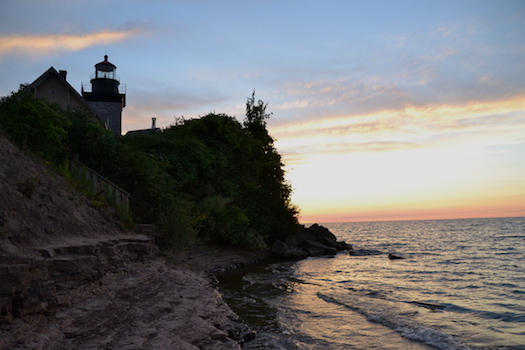IJC moving ahead with controversial plan for Lake Ontario water levels

File photo by Tom Rivers: The lighthouse at Golden Hill State Park in Barker is pictured in this photo when the sun was setting in early August.
A plan for regulating water levels at Lake Ontario is going forward despite outcries from many elected officials along the south shore of the lake, who fear water levels will have bigger swings, leading to erosion and threatening tourism industries.
Commissioners of the International Joint Commission today signed an updated order of approval regulating water levels and flows in Lake Ontario and the St. Lawrence River.
The updated order makes it possible for the IJC to approve Plan 2014, a new regulation plan for determining the flows through the Moses-Saunders Dam located on the St. Lawrence River between Cornwall, Ontario and Massena, NY. The updated order and plan replace a system of regulating flows developed in the 1950s.
“Plan 2014 is a modern plan for managing water levels and flows that will restore the health and diversity of coastal wetlands, perform better under changing climate conditions and continue to protect against extreme high and low water levels,” US Section Chair Lana Pollack said in a news release.
‘As long as I am a Member of Congress, I will fight to block any and all funding paths this plan needs to be implemented.’ – Congressman Chris Collins
Congressman Chris Collins, R-Clarence, is among the many elected officials who have been opposing the plan.
“As long as I am a Member of Congress, I will fight to block any and all funding paths this plan needs to be implemented,” Collins said in a statement today. “Additionally, the incoming Republican Administration will know from Day One how important it is to eliminate Plan 2014 once and for all.”
Collins vowed to “do everything in my power to protect the taxpayers, homeowners and small businesses along the Lake Ontario shoreline that are set to be devastated by this bureaucratic disaster.”
Plan 2014 will continue to protect shoreline property and will retain, essentially unchanged, the environmental conditions and coastal protections on the lower St. Lawrence River, below the Moses-Saunders Dam, the IJC stated today.
The plan will improve ecosystem health and diversity on Lake Ontario and the upper St. Lawrence River and provide net economic benefits, according to the IJC.
The plan will foster conditions needed to restore 64,000 acres of coastal wetlands and improve habitat for fish and wildlife. The plan will also frequently extend the recreational boating season, better maintain system-wide levels for navigation and increase hydropower production, the IJC said.
Plan 2014 is the result of more than 16 years of scientific study, public engagement and governmental review.
During the five-year Lake Ontario-St. Lawrence River Study (2000-2006), technical experts and stakeholders together built evaluation models and tested hundreds of alternatives, with public participation throughout the process. The IJC continued to optimize alternatives developed during the study and held public meetings in 2012 and public hearings in 2013 before proposing Plan 2014 to the two federal governments.
“We are pleased that Plan 2014 will bring system-wide improvements, with consideration of ecosystem health and recreational boating along with shoreline communities, commercial navigation and hydropower production,” said Canadian Section Chair Gordon Walker.
The IJC plans to implement the plan starting in January 2017.
For more information on the IJC, click here.









































































